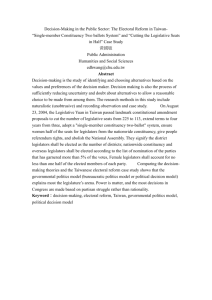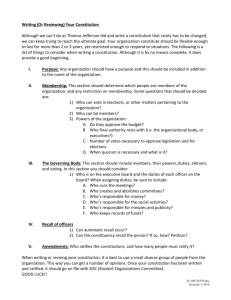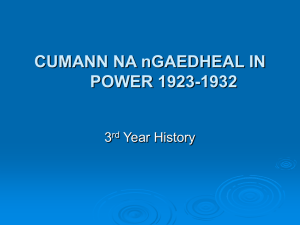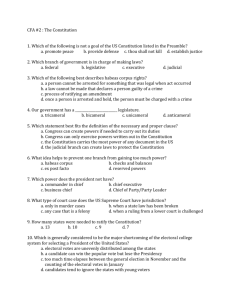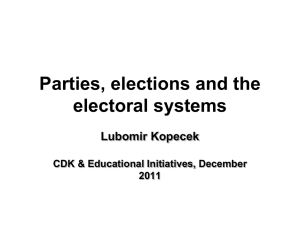No 36 by O'Connor
advertisement
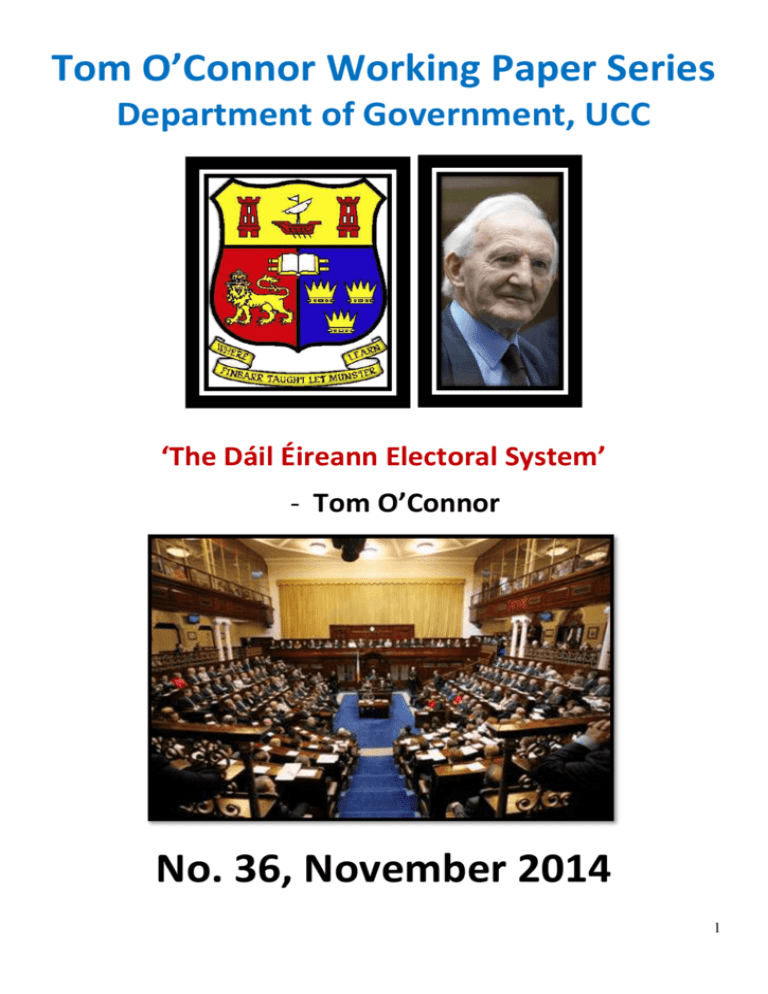
Tom O’Connor Working Paper Series Department of Government, UCC ‘The Dáil Éireann Electoral System’ - Tom O’Connor No. 36, November 2014 1 THE DÁIL ÉIREANN ELECTORAL SYSTEM Tom O’Connor Introduction This paper examines the constitutional and legislative basis for the election of members of Dail Eireann, the results of general elections and the impact of the system in contributing to viable parliamentary government. Constitution of the Irish Free State Since the foundation of the state in 1922, members have been elected to Dail Eireann by proportional representation by means of the single transferable vote (PRSTV). The Constitution of the Irish Free State 1922 stipulated that “members shall be elected on principles of Proportional Representation1”. The ensuing Electoral Act of 19232 provided that “a contested Dail (or Seanad) election shall be according to the principle of Proportional Representation, each elector having one transferable vote”3, defined as follows: The expression “transferable vote” means a vote:(a) capable of being given so as to indicate the voter’s preference for the candidates in order; and (b) capable of being transferred to the next choice when the vote is not required to give a prior choice the necessary quota of votes, or when, owing to the deficiency in the number of votes given for a prior choice, that choice is eliminated from the list of candidates4. Article 26 of the Constitution also contained provisions about the number of deputies, the need for a uniform ratio for constituency representation and the revision of constituencies every ten years, provisions which were substantially repeated in the Constitution of 1937. Bunreacht na hÉireann (Constitution of Ireland) 1937 The Constitution of 1937, which, inter alia, repealed the Constitution of 1922, provides that the members of Dail Eireann “shall be elected on the system of proportional representation by means of the single transferable vote”5 and that no constituency shall have less than three members6. It prescribes the parameters for determining the total number of members in the House and requires a consistent ratio of population per member in each constituency: 2 …the total number of members of Dail Eireann shall not be fixed at less than one member for each thirty thousand of the population, or at more than one member for each twenty thousand of the population7. The ratio between the number of members to be elected at any time for each constituency and the population of each constituency, as ascertained at the last preceding census, shall, so far as it is practicable, be the same throughout the country8. The Oireachtas shall revise the constituencies at least once in every twelve years with due regard to changes in distribution of the population…9 The actual number of members is prescribed from time to time in the Electoral Acts: the Oireachtas has invariably opted for a number close to the permitted maximum, a subject to which we return later. Proposals for constitutional change, 1959 While the electorate have broadly supported PRSTV since its inception, a Fianna Fail government has on two occasions – 1959 and 1968 – proposed a change from PRSTV to the first-past-the-post system (straight vote). In the course of his second stage speech in Dail Eireann on the Third Amendment to the Constitution Bill 1958, the Taoiseach, Eamonn De Valera, said: Its chief object is to amend the Constitution by putting, in place of the present system of the transferable vote and multi-member constituencies, single-member constituencies and the single non-transferable vote, the candidate who receives the greatest number of votes being elected10. In his view “the whole effect of the present system of PR has been to cause multiplicity of parties” 11. He argued that, in contrast, the single non-transferable vote had an “integrating tendency”. It tended “to vest the government in office with power to carry out its particular programme” while also helping “to build up an effective Opposition” to adopt policy changes “when their turn comes”12. He referred to the General Elections of successive years –1932/1933, 1937/1938 and 1943/1944 – which were designed to obtain an overall majority. He touched on the purpose of elections: When we go to an election, what do we go to the people for? As anybody who has read or made any speeches knows, the main question before the people at the time of an election is what type of government they will have for the succeeding five years, what sort of policy they will have13. 3 He went on: With the present system, there is a multiplicity of Parties, each little group trying to get some support, knowing full well that they have not the slightest chance, independently, of being the Government. Yet they can go out and promise, for that very reason, knowing that it will get them some votes14. Referring to post-election pacts, he said: “Under the system of straight voting, they will have to unite beforehand, not after. They will have to unite in front of the people”15. No doubt he was reflecting on the experience of 1948 when several parties and independent deputies formed the first inter-party government as a result of post-election negotiations. The amendment was strenuously opposed in Dail Eireann. It was deemed to “interfere with the rights of minorities”, to lead to “unrepresentative parliaments and to arrogant government” and to “make more difficult the ending of Partition”. Besides, it was seen by many, both inside and outside Dail Eireann, as a means of reinforcing Fianna Fail’s position in government. To quote David Farrell: The motivation on each occasion [1959 and 1968] was to increase the party’s chances of forming a singleparty, majority government for, despite the fact that by 1958 Fianna Fail had been in power for twentyone of the previous twenty-seven years, it had only enjoyed an overall majority on four occasions16. In any event the people were not convinced. The result of the ensuing referendum on 17 June 1959, with a turnout of 58.4%, was: In favour - 48.2% Against - 51.8% Constitutional challenge Another aspect of the electoral system soon created an unexpected constitutional challenge – the issue of representation ratios (Art.16.2.3). The Government had decided to provide for a deviation from uniform ratios in order to cater for voters in areas where population was widely dispersed. When presenting the Electoral (Amendment) Bill 1959 to Dail Eireann, the Minister for Local Government, Neil Blaney, referred to the startling variations in population densities and the special circumstances and practical problems facing a Deputy who took a responsible view of his duties. “In general, such special circumstances are mainly geographical or topographical though in some cases the claim for special consideration…may be reinforced 4 by economic factors”17. In practice these factors would suggest a more favourable representation ratio for some areas. “It is for these reasons that the proposals made in the Bill may appear, if viewed in a purely statistical light, to err on the side of leniency, so far as rural representation is concerned”18. The Bill became law but later some of its provisions faced a Court challenge from Deputy John O Donovan of Fine Gael on the grounds that it violated the principle of parity of representation. The High Court declared that the Bill did not conform with the requirements of Art. 16.2.3, Mr. Justice Budd rejecting the concept of catering for the practical difficulties encountered by Deputies. In his view “mathematical accuracy” was not required: the difficulties to be taken into account were those of an administrative and statistical nature. He explained: In the result it would seem to me that the difficulties to which the legislature should have regard are those of an administrative and statistical nature, and the principal question to decide will be as to whether equality of ratio of members to population has been achieved insofar as practicable having regard to such difficulties19. He did not specify the permissible deviation from the national average but his comments implied an acceptable maximum of 1000 (about 5%). New legislation was therefore required – the Electoral (Amendment) Bill 1961 - which the President referred to the Supreme Court under Art. 40. While the Court found that the Bill was not repugnant to the Constitution they too failed to specify an acceptable deviation. “This Court cannot, as is suggested, lay down a figure above or below which a variation from what is called the national average is not permitted”20. Yet they were prepared to declare that the divergences shown in the Bill were “within reasonable limits”. Proposals for constitutional change 1968 In 1968 the Fianna Fail Government again attempted electoral reform, launching two constitutional amendments – one to overcome the problem presented by the judgement in the O Donovan case, the other to change to the straight vote. In the course of his second stage speech on the Third Amendment of the Constitution Bill 1968, the Taoiseach, Jack Lynch, said: 5 The object …is to make the original intention of the Constitution effective, to put beyond doubt the extent to which divergence from the strict mathematical ratio is permissible and to set out expressly the special factors to be taken into account21. Hence the Bill provided for – a maximum divergence of one sixth of the national average, the need to take account of “the extent and accessibility of constituencies and the need for securing convenient areas of representation”, and the desirability of avoiding overlapping of county boundaries22. He went on to speak about the Fourth Amendment to the Constitution Bill which proposed to introduce singleseat constituencies and “the replacement of proportional representation by the relative majority system using the single transferable vote”23. He referred to the advantage of the straight vote in enabling voters to elect a government rather than depending on post-election compromises. The single seat constituency would help voters to make “an informed and effective choice between real alternatives”24. Both proposals were rejected. The results of the referenda held on 16 October 1968 were: In favour Against Third amendment 39.2% 60.8% Fourth amendment 39.2 60.8% Constituency Commission No similar proposals for constitutional amendments have emerged from any subsequent government. The electorate had spoken on two occasions within a decade and any further invitation to change would probably have induced the same reaction. Besides, the establishment of independent commissions to advise on constituency revision has removed the risk of manipulation or apparent gerrymandering and helped to reinforce acceptance of the electoral system as a whole. The first such commission was established in 1979 and the terms of reference of each commission have adhered broadly to the criteria as interpreted by the courts. Since 1997 such commissions have operated on a statutory basis. The Electoral Act 199725 provides: 6 A Constituency Commission shall, in observing the relevant provisions of the Constitution in relation to Dail constituencies, have regard to the following: (a) (b) (c) (d) (e) (f) the total number of members of the Dail, subject to Article 16.2.2 of the Constitution, shall be not less than 164 and not more than 168; each constituency shall return three, four or five members; the breaching of county boundaries shall be avoided as far as practicable, each constituency shall be composed of contiguous areas; there shall be regard to geographic considerations including significant physical features and the extent of and the density of population in each constituency; and subject to the above provisions, the Commission shall endeavour to maintain continuity in relation to the arrangement of constituencies26. Reviews of the Constitution The electoral system has been reviewed in the course of three reports on the Constitution – the Committee on the Constitution 1967 (Colley Report) 27, the Constitution Review Group 1996 (Whitaker Report)28 and the All-Party Oireachtas Committee on the Constitution 200229. The Colley Report offered no recommendation for change: in fact the Committee’s findings were deliberately inconclusive: Early on in our deliberations we decided that, where it was not possible to reach unanimity on any matter, we would set out the substantial arguments for and against each provision under consideration, leaving it to the Government of the day to decide the items which should be selected in any legislative proposals that may emerge30. The Whitaker Report endorsed the relatively favourable representation ratio in Dail Eireann. “There is no reason to suggest a change in the current ratio of population to members”31. Their views on the voting system were more expansive: The Review Group recommends that consideration of any proposal to change the electoral system should be guided by the following principles: 1 the present PR-STV system has had popular support and should not be changed without careful advance assessment of the possible effects, 2 if there were to be a change, the introduction of a PR-list or AMS system would satisfy more of the relevant criteria than a move to a non-PR system32. The 2002 report again declared its satisfaction with the representation ratio. “It is not necessary to change the current constitutional ratio of population to members”33. The Group examined various voting systems in some detail only to conclude: “The fundamental and insurmountable argument against change is that the current Irish electoral system provides the greatest degree of voter choice of any available option” 34. Hence their recommendation: ”No change to the provisions regarding Dail elections is necessary or desirable”35. To test whether such complacency is justifiable the results of general elections will now be examined. 7 Results of General Elections The members of Dail Eireann (currently 166) are elected from multi-member constituencies - 18 three member, 13 four member and 12 five member. To quote Busteed: One of the most notable features of the Irish voting system is the way in which it maximises voter choice: an elector can not only choose between parties but also express a preference on every candidate on the ballot paper. Consequently, whatever factors are important in social relations in Irish society will find a fairly true reflection in electoral behaviour. The voting system has not manufactured these features, it has merely articulated them36. Table 1 contains the results of the eleven general elections from 1969 to 2002 with figures for turnout at each election in Table 2. The data are presented diagrammatically in Appendix 1 and Appendix 2. Table 1 General Elections 1969 – 2002, First preference votes (v) and seats(s) -% Fianna Fail v s Fine Gael v s Labour PDs v v s Other s v s 1969 45.7 51.7 34.1 35.0 17.0 12.6 - 3.2 0.7 1973 46.2 47.9 35.1 37.5 13.7 13.2 - 5.0 1.4 1977 50.6 56.8 30.5 29.1 11.6 11.5 - 7.3 2.6 1981 45.3 47.0 36.5 39.2 9.9 9.0 - 8.3 4.8 1982(F) 47.3 48.8 37.3 38.0 9.1 9.0 - 6.3 1982(N) 45.2 45.2 39.2 42.2 9.4 9.6 - 6.2 3.0 1987 44.2 48.8 27.1 30.7 6.4 7.2 11.9 8.4 1989 44.2 46.4 29.3 33.1 9.5 9.0 5.5 1992 39.1 41.0 24.5 27.1 19.3 19.9 1997 39.3 46.4 28.0 32.5 2002 41.5 48.8 22.5 18.7 4.1 10.4 4.9 3.6 11.5 7.9 4.7 6.0 12.4 6.0 10.4 10.2 4.7 2.4 17.6 8.5 10.8 12.7 4.0 4.8 21.2 15.0 F - Feb., N - Nov. Source: Department of the Environment, Heritage and Local Government 8 Table 2 General Elections 1969-2002, Turnout (%) 1969 76.9 1973 76.6 1977 76.3 1981 76.2 1982 (Feb) 73.8 1982 (Nov) 72.9 1987 73.3 1989 68.5 1992 68.5 1997 65.9 2002 62.6 Source: Department of the Environment, Heritage and Local Government The results overall reflect a close correlation between the percentage of votes and seats obtained by the parties, particularly by Fianna Fail, Fine Gael and Labour. To that extent PRSTV as operated in the Republic of Ireland can be deemed an equitable system. Yet there is another dimension to be considered – the election of a government and the balance of power as between the party or parties in government and in opposition. Table 3 gives the number of seats (excluding the Ceann Chomhairle) held by the Party (Parties) in Government and the Opposition following the General Elections of 1969 to 2002. 9 Table 3 Dail Eireann, No. of seats Government Opposition Government majority 1969 (FF) 74 69 5 1973 (FG/Lab) 73 70 3 1977 (FF) 84 63 21 1981 (FG/Lab) 80 85 -5 1982 (Feb) (FF) 81 84 -3 1982 (Nov.) (FG/Lab) 86 79 7 1987 (FF) 81 84 -3 1989 (FF/PD) 83 82 1 1992 (FF/Lab) * 101 64 37 1997 (FF/PD) 83 82 1 2002 (FF/PD) 88 77 11 * The Government changed in December 1994 without a dissolution of the Dail. The new Government was three-party – Fine Gael, Labour and Democratic Left (the Rainbow Coalition) Apart from the elections of 1977 when Fianna Fail obtained a majority of 21 seats and 1992 when the Fianna Fail/Labour Coalition had a majority of 37, Governments have had to operate with slender margins or, on some occasions, from minority positions depending on support from Independents. Coalition government is becoming the norm. Different parties come together to form coalitions, a disturbing trend being that some governments are emerging from post-election bargaining. Peter Mair asks: “If coalition politics in the coming decades becomes a matter of musical chairs – or musical beds – how should voters go about choosing between the parties? More to the point, why should voters even bother to try to choose between the parties?”37 This contrasts with the situation in the United Kingdom where, under the straight vote (first past the post), a Government can regularly have a substantial majority in the House of Commons. However the U.K. electorate rightly complain about the inequity of a system which yields major disparities between voting support and seats won as the figures in Table 4 illustrate. 10 Table 4 United Kingdom, Results of General Election 2005 Votes (%) Seats (%) Labour 35.3 55.2 Conservative 32.4 30.5 Liberal 22.1 9.6 Other 10.2 4.7 Detailed results of general elections in the United Kingdom for 1970 to 2005 are given in Appendix 2, Appendix 3 and Appendix 4. Options for change The electorate in the Republic already rejected proposals to introduce the straight vote for elections to Dail Eireann – the referenda of 1959 and 1968. Some alternatives may be considered, the objective being to select a system which recognises the principle of proportionality yet provides the necessary stability for the party or coalition of parties entering government. Any new system should also release deputies from the difficulties inherent in a multi-member constituency. The All Party Oireachtas Committee were told: “There is an evergrowing emphasis on clientelism and intense, even vicious, intra-party competition which is wasteful of resources and leads to a culture of ‘gombeenism’”38. In the course of a study for the Committee, Michael Laver, Professor of Political Science at Trinity College Dublin, recommended the Additional Member System (AMS). Under AMS one half of the members are elected from single seat constituencies on a first-past-the-post basis and the remainder are elected from a party list. The list seats are allocated on a basis which ensures that the results overall reflect party electoral support, correcting any imbalances which arise from the direct constituency results. To quote Laver: AMS provides a response to the main criticisms of STV from Irish politicians, in using single seat constituencies, while at the same time delivering the proportional representation that represents “best practice” for any electoral system by accurately reflecting the wishes of the voters in the final election result39. 11 Yet all list systems have serious flaws. The wishes of the voters are severely restrained as the names on the list are determined by the party hierarchy. Choice is diverted from the electorate to the party chiefs. As Deputy Sean Fleming informed the All Party Committee, “it is intrinsically undemocratic and is designed to eliminate the people’s right to elect or not to elect specific individuals to the National Parliament”40. Potential candidates would also be at a disadvantage. “Competition between party candidates would […] be transferred from a competition for votes to a competition for the favour of party insiders”41. Besides, there is a large degree of ambivalence in constituency representation. Those elected from the party list will surely give priority to party interests and display little commitment to constituency matters. While AMS provides for a mixture of constituency and list candidates the electoral system in some countries is based exclusively on list candidates. In such cases electors may express their preferences as between candidates or they may be required to vote for party candidates en bloc, an extreme form of party domination. One could not therefore recommend the list system in any of its forms for the electorate in Ireland. A better option would be to modify the PR system which has operated since the foundation of the state – retain PR but in single-seat constituencies, known as the Alternative Vote (AV). Referring to the impact of this system as used in federal elections in Australia, Farrell concludes: Smaller parties are disadvantaged: larger parties are advantaged: parties with a good geographical concentration in support tend to do better, and governments with a majority of seats are the norm42. The AV system retains the element of preference but gives more decisive results. Michael O Kennedy, a former Fianna Fail minister, advocated AV in the course of his evidence to the All-Party Oireachtas Committee: The system tends to deliver a clear result and stable government; electors are already familiar with the system through voting at bye-elections and they retain choices in relation to their scale of preferences; the distractions and conflicts arising from the present system would disappear; electors desirous of a change of government could bring this about quite effectively under such a system43. Obviously it would be more difficult for small parties and independents to win seats but this in itself is not a major defect considering that interest groups in Ireland are highly organised and have ready access to ministers, parliamentary committees and government departments. AV would concentrate the mind of the 12 voters, some of whom express their preferences for candidates on a very personal, and almost random, basis without reflecting on the ultimate objective of electing a government. Garret FitzGerald comments on a special feature of such personalised voting: …the electorate, who vote for individual candidates rather than for parties, can choose between different members of the same party. As a result of this the chances of members losing their seats is approximately doubled, indeed trebled in the case of Fianna Fail. For overall, approximately half of the seats lost by members of the two larger parties are lost to other members of their own group rather than to members of others parties44. Changing to single seat constituencies should alleviate the burden of constituency work, a task which is marked by intense local rivalry. As MacCarthaigh explains: The emphasis on constituency service means that much of political life in Ireland appears to be based on personality rather than policy, on constituency issues rather than national issues, and on delivery of services and favours rather than reform of institutions that would make these personal interventions unnecessary45. Besides, the reduction of constituency work would be in keeping with the abolition of the dual mandate, a development which, in effect, separates the role of councillor and parliamentarian. Under the Local Government (No.2) Act 200346, “a person who is a member of either House of the Oireachtas is disqualified from being elected or co-opted to, or from being a member of, a local authority”47. As Martin Cullen, Minister for the Environment, Heritage and Local Government, explained in Dail Eireann: The ending of the dual mandate will allow local government to develop its own separate role within our democracy for the first time since the foundation of the State. No longer will the conduct of council business be subject to such external influences as parliamentary timetables, nor should it be48. Similarly deputies should be released from their preoccupation with local issues and, hopefully, the electorate will eventually recognise that development. Edmund Burke’s advice to the electors of Bristol springs to mind:: Parliament is a deliberative assembly of one nation, with one interest, that of the whole: where not local purposes, not local prejudices, ought to guide, but the general good, resulting from the general reason of the whole. You choose a member indeed, but when you have chosen him, he is not a member of Bristol, but he is a member of parliament49. Representation ratio We now come to the question of the representation ratio. While changing to single-seat constituencies does not of itself entail a change in the number of deputies it is of interest to review the position in other states. Table 5 shows population, number of members in the Lower House and the population per member for each state in the European Union. Population per member ranges from 124,600 in Germany to 6,200 in Malta. 13 Ireland, with only 23,600 per member – 166 members in total - has a very favourable ratio. The only states with a lower population per member are Cyprus, Estonia, Latvia, Luxembourg, Malta and Slovenia. Traditionally the number of deputies in Ireland has been close to the maximum permitted by the Constitution50. If based on the authorised minimum the number of deputies would be 130. Table 5 Representation (Lower House) in member states of the European Union Austria Population (m.) 8.1 Number of members (Lower House) 183 Belgium 10.4 150 69,300 Cyprus 0.7 80 8,800 Czech Republic 10.2 200 51,000 Denmark 5.4 179 30,200 Estonia 1.4 101 13,900 Finland 5.2 200 26,000 France 59.6 577 103,300 Germany 82.5 662 124,600 Greece 11.0 300 36,700 Hungary 10.1 386 26,200 3.9 166 23,600 57.3 630 91,000 Latvia 2.3 100 23,000 Lithuania 3.5 71 49,300 Luxembourg 0.4 60 6,700 Malta 0.4 65 6,200 Netherlands 16.2 150 108,000 Poland 38.2 460 83,000 Portugal 10.4 230 45,200 Slovakia 5.4 150 36,000 Slovenia 2.0 90 22,200 40.7 350 116,300 Sweden 8.9 349 25,500 United Kingdom 59.3 659 90,000 Ireland Italy Spain Population per member 44,300 Source: European Commission 14 There is no scientific basis for determining the optimum representation ratio. The important issue is not the number of members per se but their role and performance in a democracy. These factors in turn are a function of the status of the state and the constitutional distribution of power within it. Is it a federal or unitary state, has it a unicameral or bicameral legislature, to what extent is power devolved to regional and local authorities? For example, Germany has a low ratio of one member per 124,600 people in the national parliament (Bundestag) but, being a federal state, power is widely distributed and members states of the federation exercise significant influence on public policy and legislation through their representation in the Upper House (Bundesrat). There is no compelling reason for reducing the number of deputies in Dail Eireann though there is ample scope for a programme of parliamentary reform to enhance their effectiveness. In any event it would be unwise to proceed with any change in the representation ratio in tandem with the more pressing need for a change to single-seat constituencies. This development of itself would demand some radical adaptation in Irish political culture. Conclusion The basic feature of the electoral system for Dail Eireann is the use of the single transferable vote in multimember constituencies. On the whole it has given equitable election results with a broad correlation between the percentage of votes and seats obtained by competing political parties. The main criticism is that such results are so evenly balanced that it is difficult to form a government with a working majority and the capacity to take decisive action from time to time. Coalition government has become the norm and, while one cannot object to coalitions as such, it is regrettable that such coalitions often emerge from post-election bargaining. The other problem is the multi-seat constituency which creates a pervasive clientelism. This leads to relentless competition not only between parties but between members of the same party and diverts attention from parliamentary duties to the constant preoccupation with local issues. 15 This paper recommends the retention of preferential voting but in single-seat constituencies – the alternative vote – with the objective of yielding more decisive election results. There is no pressing need to change the representation ratio. In any event it would be unwise to tamper with the number of deputies at a time when the electorate were being asked to adapt to single-seat constituencies. 16 References 1.Art. 26. 2.No.12 of 1923. 3.Section 17(1). 4.Section 17(2). 5.Art. 16.2.5. 6.Art. 16.2.6. 7.Art. 16.2.2. 8.Art. 16.2.3. 9.Art. 16.2.4. 10. Dail Debates 26 Nov 1958, Vol.171, cols. 990/991. 11.Ibid., col. 995. 12.Ibid., col. 993. 13.Ibid., col. 997. 14.Ibid. 15.Ibid. 16.David M.Farrell Comparing Electoral Systems, London: Macmillan Press 1998, p.115. 17.Dail Debates 28 Oct. 1959, Vol. 177, col. 379. 18.Ibid., col. 381. 19.Donovan v. Attorney General [1961] I.R.114. 20.In re Article 26 of the Constitution and the Electoral (Amendment) Bill 1961 I.R. 183. 21.Dail Debates 28 Feb. 1968, Vol. 232, col. 1944. 22.Ibid., col. 1946. 23.Ibid., col. 1949. 24.Ibid., col. 1957. 25.No. 25 of 1997. 26.Section 6. 27.Report of the Committee on the Constitution, 1967, Pn.9817. 28.Report of the Constitution Review Group, May 1996, Pn.2632. 29.The All-Party Oireachtas Committee on the Constitution, Seventh Progress Report, Parliament, 2002, Pn.11281. 30.Colley Report, par.5. 31.Whitaker Report, p.51. 17 32.Ibid., p.60. 33.All-Party Oireachtas Committee Report. p.13. 34.Ibid., p.29. 35.Ibid. 36.M.A.Busteed Voting Behaviour in the Republic of Ireland, A Geographical Perspective, Oxford: Clarendon Press 1990, p.72. 37.Peter Mair Coalition Evermore? Party Politics in Ireland in the Twenty-First Century, Address at Dublin Castle (UCD Politics Programme), 26 Feb. 1998. 38.All-Party Oireachtas Committee Report, p.12. 39.Michael Laver A New Electoral System for Ireland?, Dublin: The Policy Institute, Trinity College Dublin, 1998, p.42. 40.All-Party Oireachtas Committee Report, p.22 41.Laver, op.cit., p.18. 42.Farrell, op.cit., p.53. 43.All-Party Oireachtas Committee Report, p.20. 44.Garret FitzGerald Reflections on the Irish State, Dublin: Irish Academy Press, 2003, p.92. 45.Muiris MacCarthaigh Accountability in Irish Parliamentary Politics, Dublin: IPA, p.294. 46.No.17 of 2003. 47.Section 2(1). 48.Dail Debates 3 April 2003, Vol. 564, col.647. 49.Address to the Electors of Bristol, 3 November 1774. 50.Art.16.2.2. 18 Appendix 1 Republic of Ireland: Results of General Elections, 1969 - 2002 % First Preferences: % Seats by Party 60 FF 50 % of 1st Preferences % of Seats 40 % of 1st Preferences FG % of Seats % of 1st Preferences % of Seats 30 % of 1st Preferences % of Seats % of 1st Preferences 20 Lab % of Seats PDs 10 Other 0 1969 1973 1977 1981 1982 1982 1987 Feb Nov Year 1989 1992 1997 2002 19 Appendix 2 Republic of Ireland: Turnout at General Elections 1969 - 2002 100 % Turnout 80 76.9 76.6 76.3 76.2 73.8 73.3 72.9 68.5 68.5 65.9 62.6 1989 1992 1997 2002 60 40 20 0 1969 1973 1977 1981 1982 1982 Feb Nov 1987 Year United Kingdom: Turnout at General Elections 1970 - 2001 100 % Turnout 80 78.8 72.0 72.8 76.0 72.7 75.3 77.7 71.5 60 59.4 61.0 2001 2005 40 20 0 1970 1974 Feb 1974 Oct 1979 1983 1987 1992 1997 Year 20 Appendix 3 United Kingdom Results of General Elections, 1970 – 2005, votes(v) and seats(s ) – percentages Labour v s Conservative v s Liberal Other v s v s 1970 43.0 45.6 46.4 52.4 7.5 1.0 3.1 1.0 1974 37.1 47.4 37.9 46.8 19.3 2.2 5.7 3.6 39.2 50.2 35.8 43.6 18.3 2.0 6.7 4.2 1979 36.9 42.4 43.9 53.4 13.8 1.7 5.4 2.5 1983 27.6 32.2 42.2 61.1 25.4 3.5 4.8 3.2 1987 30.8 35.2 42.3 57.8 22.6 3.4 4.3 3.6 1992 34.4 41.6 41.9 51.6 17.8 3.1 5.9 3.7 1997 43.2 63.4 30.7 25.0 16.8 7.0 9.3 4.6 2001 40.7 62.5 31.6 25.2 18.3 7.9 9.4 4.4 2005 35.3 55.2 32.4 30.5 22.1 9.6 10.2 4.7 (Feb.) 1974 (Oct.) Source: General Elections in the UK (Foreign and Commonwealth Office, London) 21 Appendix 4 United Kingdom: Results of General Elections, 1970-2005 % Votes: % Seats by Party 70 60 Lab 50 % of Votes % of Seats % of Votes 40 Lab Con Con 30 % of Seats % of Votes % of Seats % of Votes Lib 20 % of Seats Other 10 Lib Other 0 1970 1974 1974 Feb Oct 1979 1983 1987 1992 1997 2001 2005 Year 22 23
